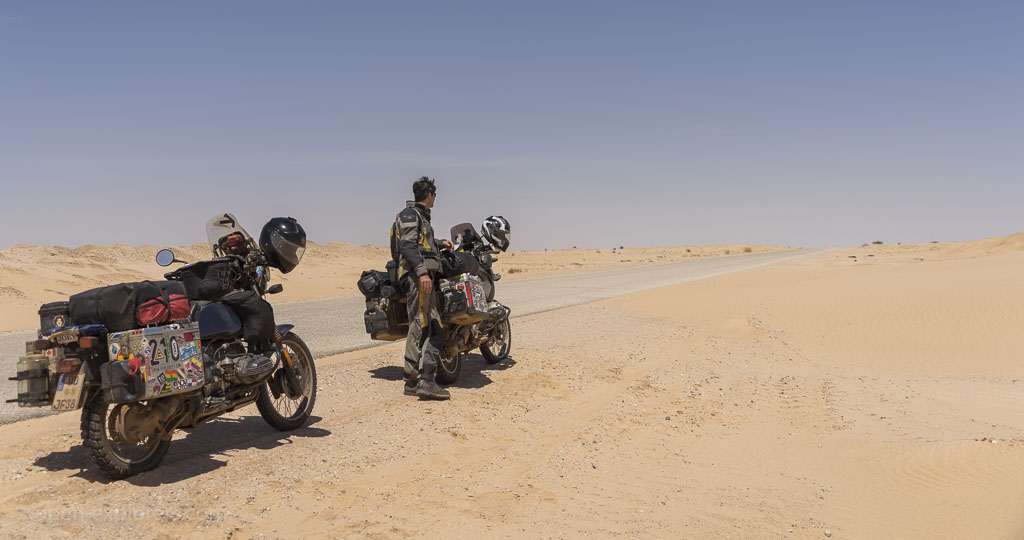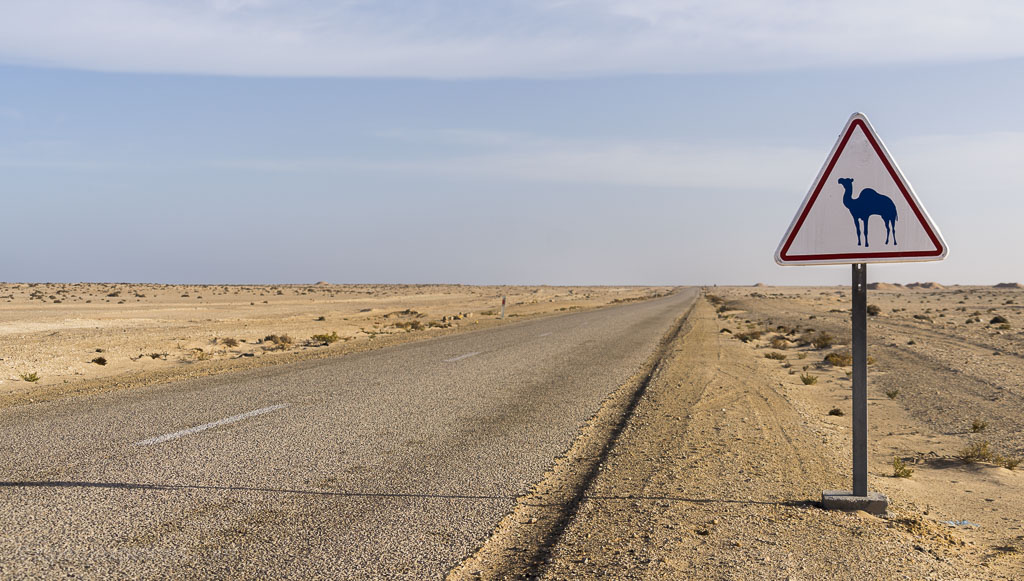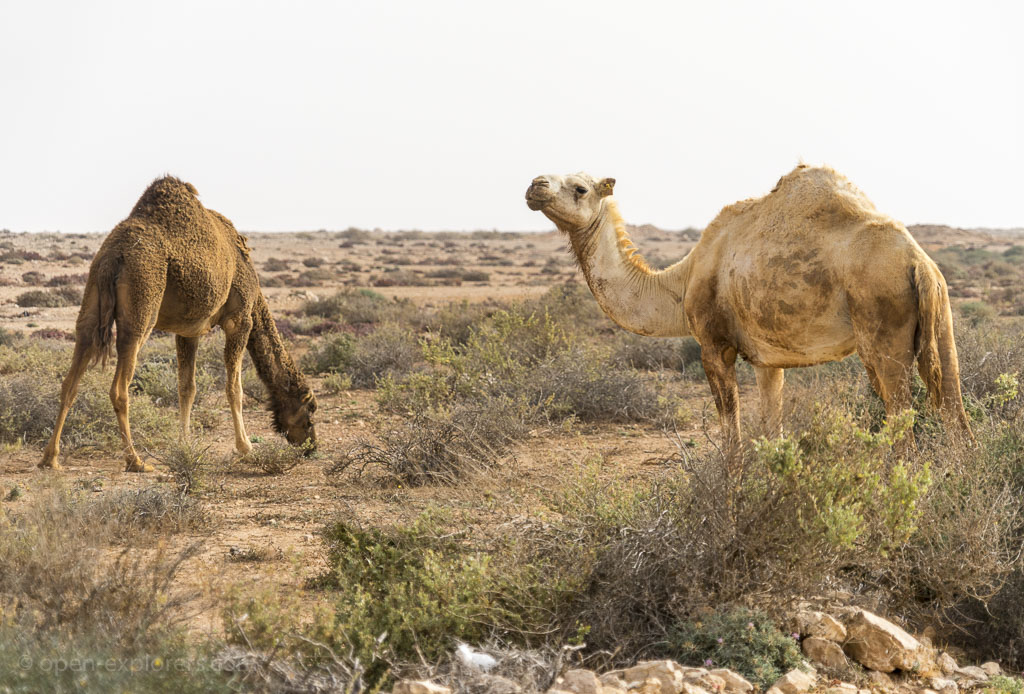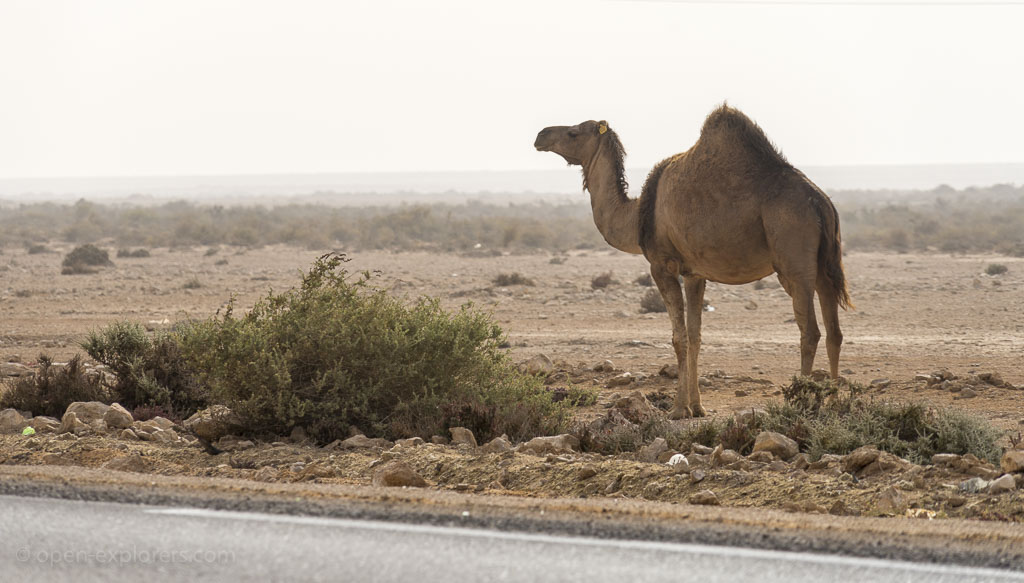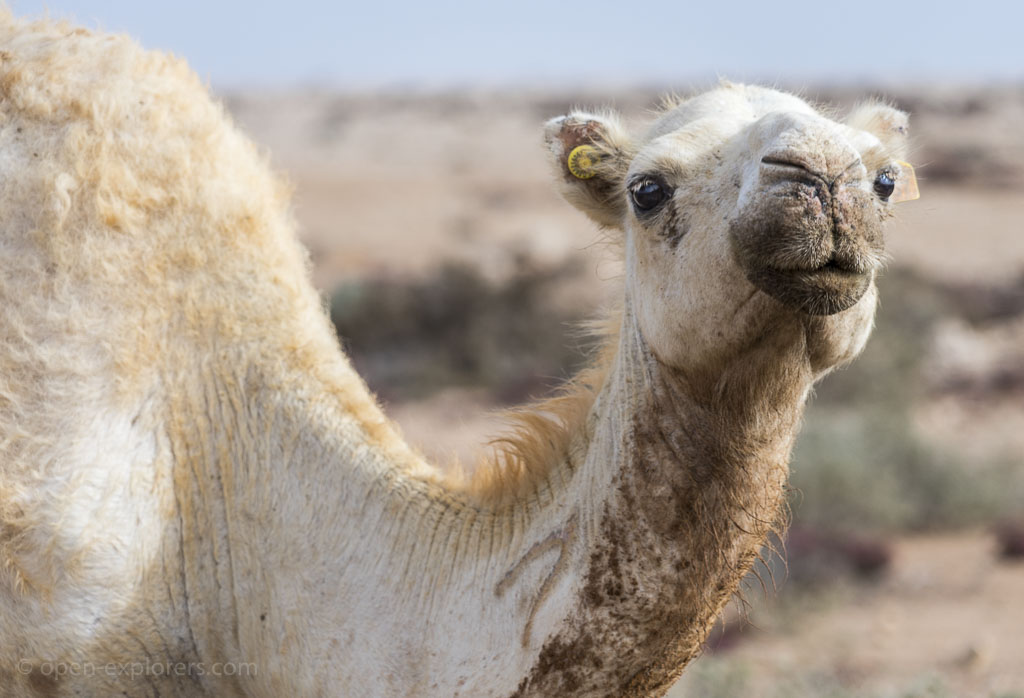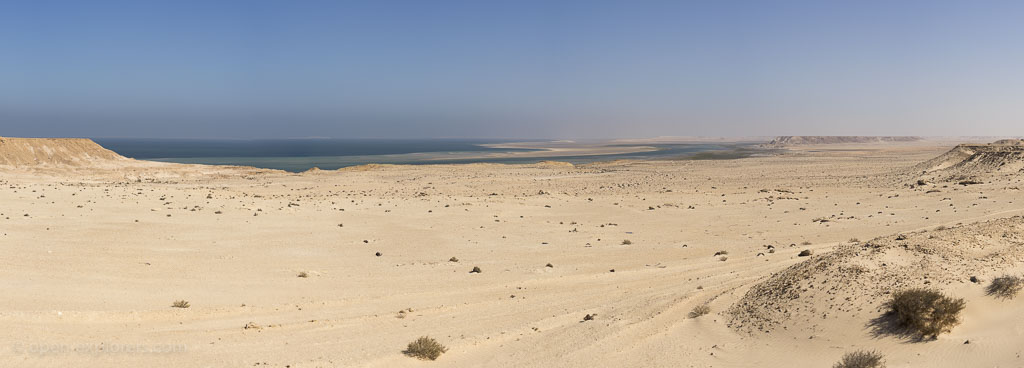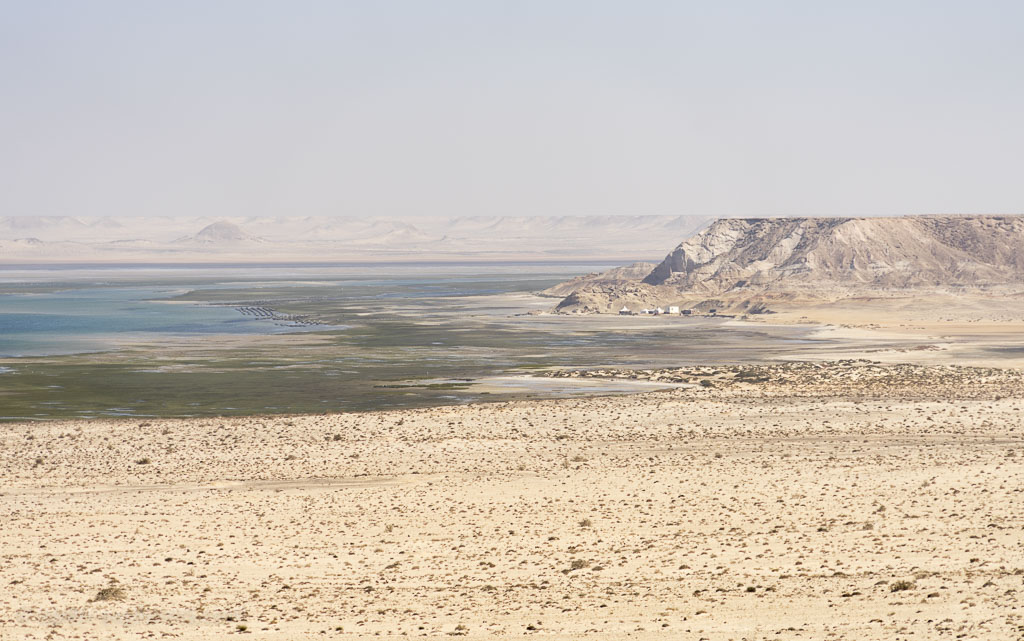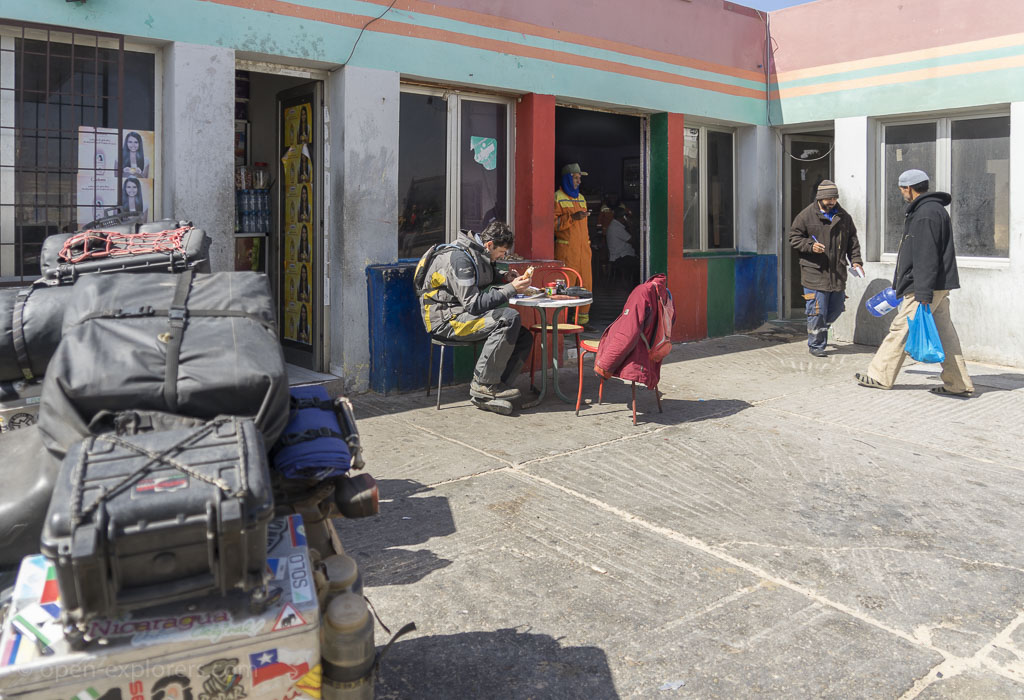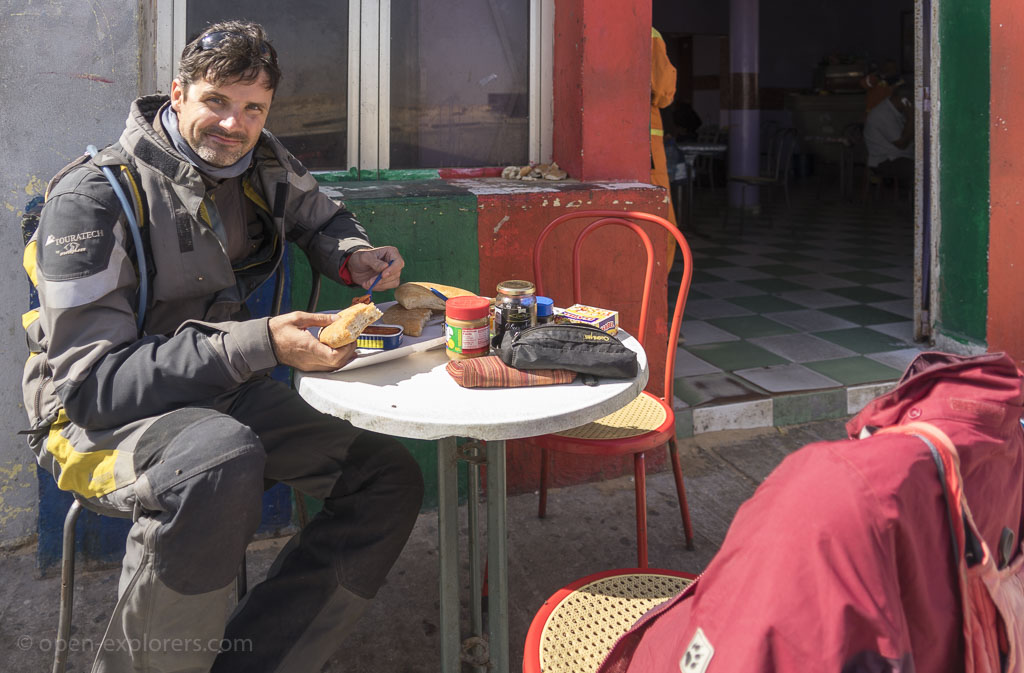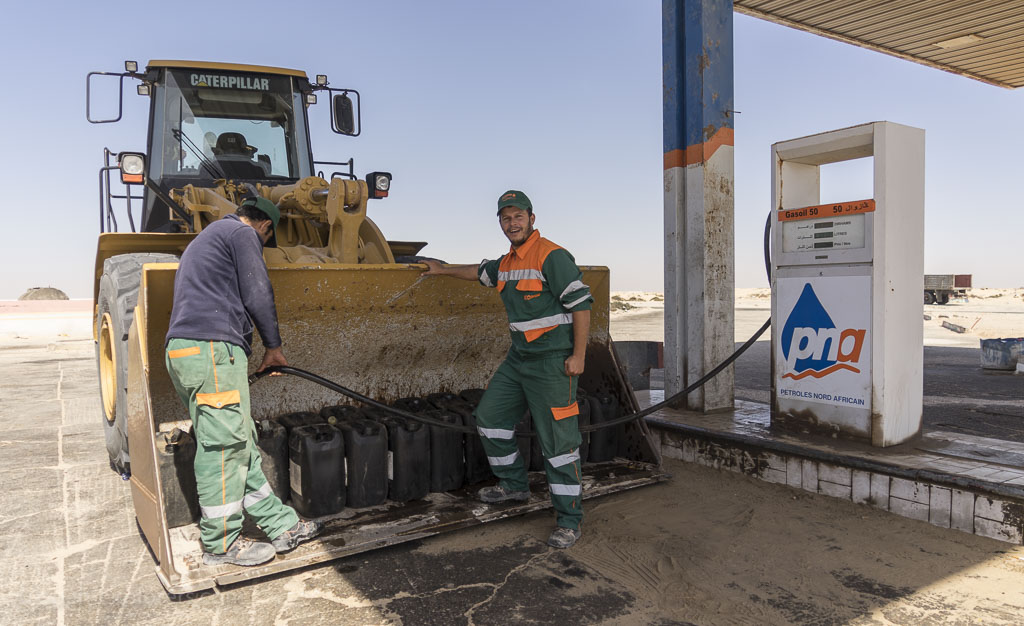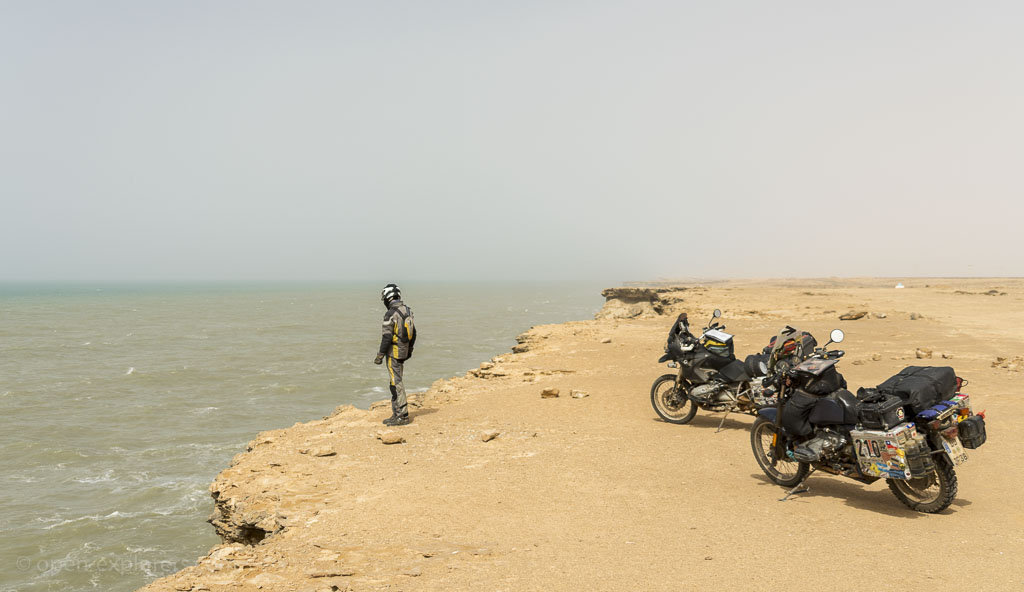Day 1078-1082 - The long haul through the desert
Usually the transition from one vegetation or climate zone to another and the passage from a certain cultural area to a different one are gradual and take place slowly. In Mauritania however, it felt like everything changed instantly at the border post. Almost all trees disappeared and all we could see behind the barrier were sand and rocks. Men with turbans wound around their heads and sometimes pulled in front of their faces were siting around, chatting with each other and drinking tea from small glasses. For months we haven’t been noticing any longer that the colour of our skin is different to everyone elses around us, but this abrupt leap into the Arab world couldn’t go unnoticed. Gone were the dark-skinned face, ever smiling and flashing rows of perfect white teeths, gone the elaborately plaited hairdos of the women and gone the colourful clothes. Instead we see beards, long and loose robes in light tones, turbans and distinct arab looks. And we hear a language of which we don’t understand the least bit and the sound of which we have yet to get used to. At the border of Mauritania we enter an Africa that’s very different from the one we’ve experienced so far. So here we are – on the doorstep of the largest arid desert in the world. And as if to make the cliché Sahara picture perfect a group of camels trudged across the road right behind the border.
It took us 5 days of riding 500km each to see some green again. Those 5 days have been everything from beautiful and ever-varying shapes and shades of grey and yellow to quite boring and way too windy. After we had crossed the national park that is located on the coast right behind the border with Senegal which is a very important breeding ground for countless birds, the following two days nothing changed. We broke the journey in the capital Nuakchott, got petrol at the only petrol station between the two major cities and intended to also stop in Nouhadibou, but spontaneously decided to push on a little further and into Western Sahara.
A few hundred meters after we officially checked out of the Islamic Republic of Mauritania the long straight road through the desert ended abruptly and we had to find our way through a bumpy, empty nothingness of about 1-2 km in width. We could already see the Moroccan border post and the beginning of a brand-new tarmac road when we were stopped by an armed soldier who wanted to see our documents. The young guy walked around each of the bikes about 5 times and had a real close look at them. He then waved us through. But an older soldier who up until that moment had been sitting on a busdrivers seat that had been extracted from the bus, decided that he too wanted to check us out. Next to the checkpoint a hill rose about 20-30m above the surrounding area and on top of it stood a white campervan with „UN“ in big fat letters on its side. Next to it was another vehicle of the United Nations and a bunch of guys with binoculars closely watching every move of the soldiers below. Of course there is a reason for this rather bizarre szenario.
Whether Western Sahara is a proper country or a province of Morocco is a fiercly disputed matter, that is best not brought up in „mainland“ Morocco. A former Spanish colony, the territory in the desert was annexed by Morocco in 1975 the moment Spain withdrew. Since then it has been the subject of a long-running armed territorial dispute between Morocco and its indigenous Saharawi people, led by the Polisario Front. The Sahrawi Arab Democratic Republic (SADR) was proclaimed in 1976 (and recognized by 40 nations) but since it’s birth it’s been gradualy stripped of it’s claimed territory and the natural resources it contains. Now only about a fourth of the Western Sahara is controlled by the SADR and a great part of the Saharawi population including the government remains in exile in neighboring Algeria, it’s most important supporter. The people live in large refugee camps in an inhospitable desert environment depending 100% on foreign aid.
Though a ceasefire agreement has been signed in 1991, fighting occasionally occurs along the 2.700km long berm (a guarded and mined sand and stone wall functioning as a buffer strip). But it’s only since August 2016 that the conflict has returned to the southern buffer strip between the Mauritanian and Morrocan Guerguerat border – where all trans-Sahara traffic has to cross. Tension has been building up steadily and threatened to escalate into a violent confrontation between the Polisario and Morrocan military in Febuary 2017. Both blocks sent more and more armed soldiers (in numers that surpassed those from 1991) that were located in the narrow sliver of land that is the buffer strip with only 200m left between them. Apparently the situation has cooled off a little and a few weeks later when we passed through the area we only saw a few soldiers. However, the conflict is far from being over and given the complicated circumstances it seems that there will never be a satisfying solution found.
Joey
Tag 1078-1082 - Der lange Ritt durch die Wüste
Normalerweise ist der Übergang von einer Vegetations- oder Klimazone in eine andere und von einem zum nächsten Kulturkreis sanft und passiert allmählich. In Mautetanien hatten wir jedoch den Eindruck, dass sich an der Grenze schlagartig alles veränderte. Die Bäume waren verschwunden und hinter dem Schlagbaum sahen wir nur noch Sand und Gestein. Überall saßen Männer mit Turbanen auf dem Kopf, die sie teilweise auch vor die Gesichter gezogen hatten und tranken Tee aus kleinen Gläsern. Schon seit Monaten hatten wir nicht mehr wahrgenommen, dass wir eine andere Hautfarbe haben als alle Menschen um uns herum, aber dieser abrupte Wechsel in die Arabische Welt war unübersehbar. Verschwunden die dunkelhäutigen immer lächelnden Gesichter mit strahlendweissen Zähnen, verschwunden die aufwendigen Flechtfrisuren der Frauen und verschwunden die bunten Klamotten. Stattdessen sehen wir Bärte, arabische Gesichtszüge, lange, weite Gewänder in hellen Tönen, Turbane, und hören eine Sprache von der wir überhaupt nichts verstehen und an deren Klang wir uns erstmal gewöhnen müssen. Hier beginnt definitiv ein ganz anderes Afrika als wir es bisher erlebt haben. Da waren wir also – am Anfang der größten Trockenwüste der Welt. Und wie um das Klischee-Sahara-Bild perfekt zu machen latschte direkt hinter der Grenze auch gleich eine Gruppe Kamele quer über die Straße.
Es hat 5 Tage mit jeweils 500 Fahrkilometern gebraucht bis wir wieder etwas Grün gesehen haben. In diesen 5 Tagen war alles von wunderschön und immer wechselnden Formen, Grau- und Gelbtönen bis langweilig und viel zu windig dabei. Nachdem wir den Nationalpark der sich gleich hinter der Grenze zum Senegal an der Küste befindet und wichtige Brutstätte unzähliger Vogelarten ist, passiert hatten passierte die folgenden 2 Tage erstmal nicht viel. Wir machten in der Haupstadt Nuakchott Zwischenstopp, füllten unsere Tanks an der einzigen Tankstelle zwischen den beiden großen Städten und wollten eigentlich auch in Nouhadibou noch einmal anhalten. Entschieden uns dann aber spontan noch ein wenig weiter zu fahren, bis wir die Westsahara erreichten.
Ein paar hundert Meter nachdem wir offiziell die Islamische Republik Mauretanien verlassen hatten endete die Straße abrupt und wir mussten uns unseren eigenen Weg durch ein etwa 1-2km breites, steiniges Nichts suchen. Wir konnten bereits den marokkanischen Grenzposten und den Anfang einer brandneuen Teerstraße sehen als uns ein bewaffneter Soldat anhielt und unsere Dokumente forderte. Der jungsche Typ lief ungefähr 5 Mal um jedes Motorrad und schaute sich alles ganz genau an. Dann gab er uns ein Zeichen weiterzufahren. Doch ein älterer Soldat der bis zu diesem Moment auf einem Busfahrersitz in der Landschaft gehockt hatte, wollte nun auch noch mal ein bisschen wichtig sein und uns unter die Lupe nehmen. Ein Stück abseits des Checkpoints erhob sich ein Hügel etwa 20-30 Meter über die Umgebung. Oben drauf stand ein Wohnwagen auf dem UN in dicken, fetten Buchstaben stand. Daneben befand sich noch ein Fahrzeug der Vereinten Unionen und ein paar Männer mit Ferngläsern, die jeden Schritt der Soldaten beobachteten. Natürlich gibt’s für dieses doch recht bizarre Szenario auch eine Erklärung .
Ob die Westsahara nun ein eigenen Land oder eine Provinz Marokkos ist, ist ein heftig umstrittenes Thema, das man lieber nicht auf dem marokkanischen „Festland“ anspricht. Ehemals eine Spanische Kolonie, wurde das Territorium in der Wüste 1975 sofort von Marokko beschlagnahmt, als die Spanier abzogen. Seit dem ist es Gegenstand eines langen, bewaffneten Territorialdisputs zwischen den Marokkanern und den einheimischen Sahrauis, die von der Polisario Front angeführt werden. Die Demokratische Arabische Republik Sahara (DARS) wurde 1976 proklamiert (und ist von 40 Nationen als solche anerkannt) wurde seit dem aber nach und nach von ihrem beanspruchten Territorium und dem Zugang zu dessen natürlichen Ressourcen zurück gedrängt. Heute kontrolliert die DARS nur noch etwa ein Viertel der Westsahara und große Teile der Bevölkerung sowie auch die Regierung haben sich ins Exil ins benachbarte und unterstützende Algerien zurück gezogen. In riesigen Flüchtlingscamps leben die Menschen dort in einer unwirtlichen Wüstenlandschaft komplett abhängig von externer Unterstützung.
Trotzdem 1991 ein Waffenstillstandsabkommen geschlossen wurde kommt es entlang des 2.700km langen Berms (ein geschützter und verminter Sand- und Steinwall der als Pufferzone fungiert) gelegentlich zu gewaltsamen Auseinandersetzungen. Aber erst seit August 2016 ist der Konflikt auch wieder in die südliche Pufferzone zwischen Mauretanien und der marokkanischen Guerguerat Grenzstation – durch die jeglicher Trans-Sahara Verkehr passieren muss – zurück gekehrt. Die Spannungen in dem schmalen Landstreifen stiegen nach und nach und drohten im Februar 2017 zu eskalieren. Beide Fronten sendeten mehr und mehr bewaffnete Soldaten, die selbst die Zahlen von 1991 übertrafen und sich nun in einem gefährlich geringen Abstand von nur 200m gegenüberstanden. Scheinbar hat sich die Situation nun wieder ein wenig abgekühlt, as wir wenige Wochen später durch die Zone kamen, haben wir nur noch wenige Soldaten gesehen. Der Konflikt jedoch, ist noch lange nicht vorbei und in Anbetracht der vertrackten Situation macht es auch nicht den Anschein, als ob jemals eine Lösung gefunden werden kann.
Joey
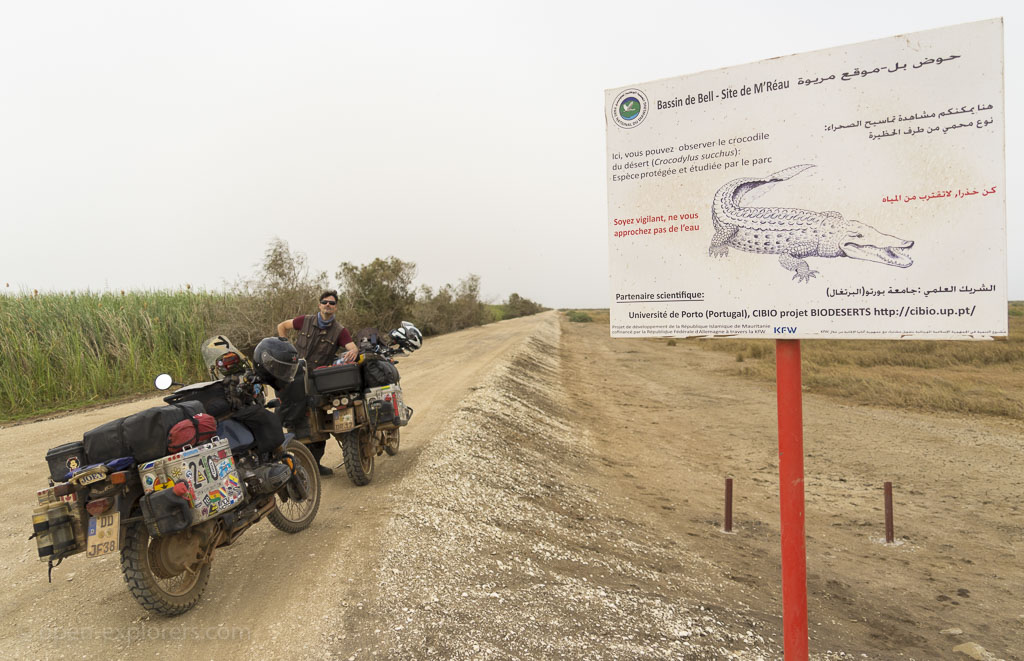
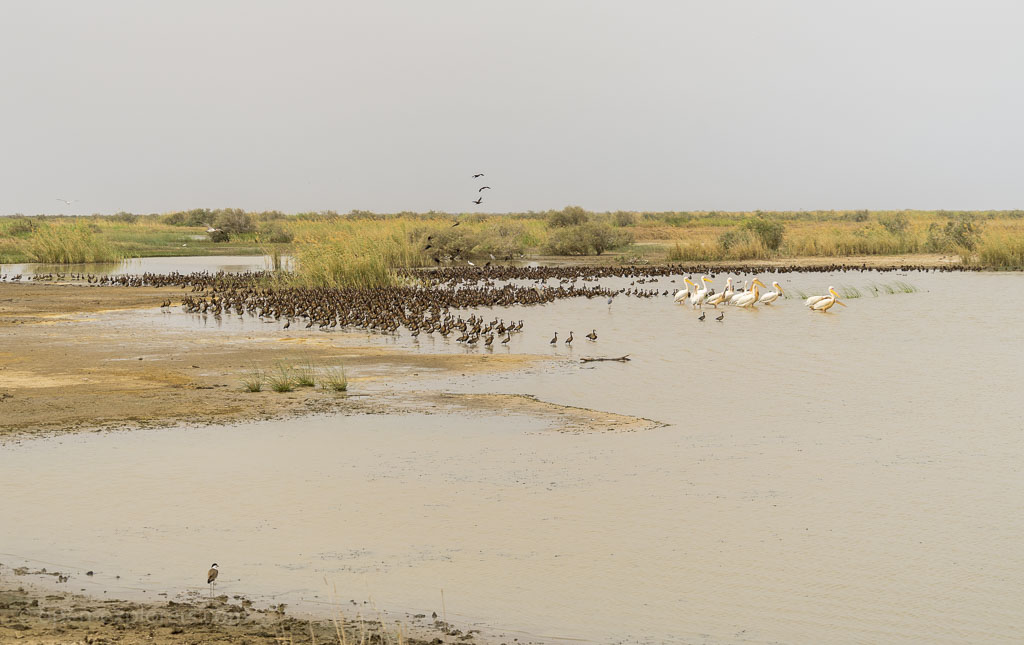
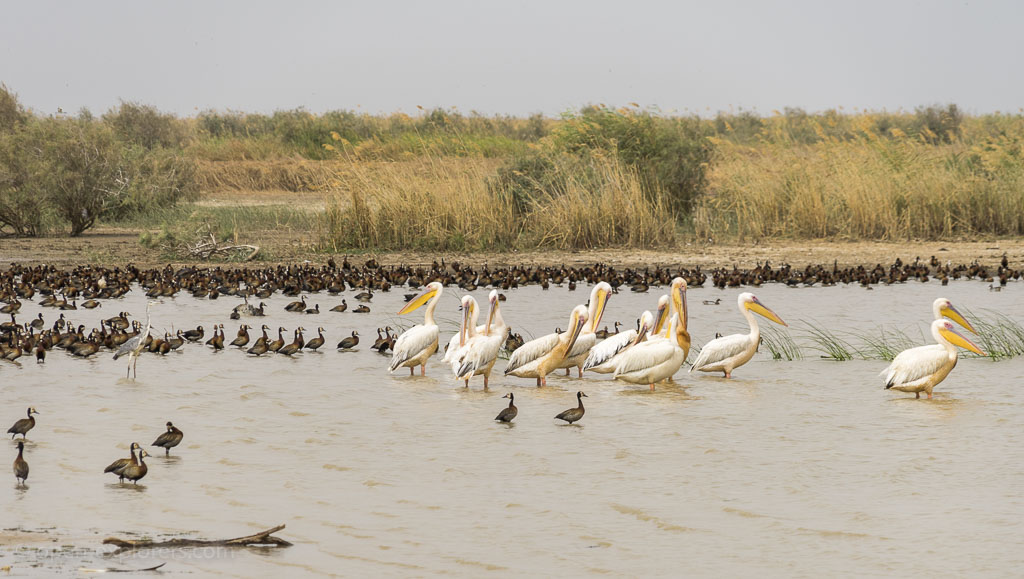
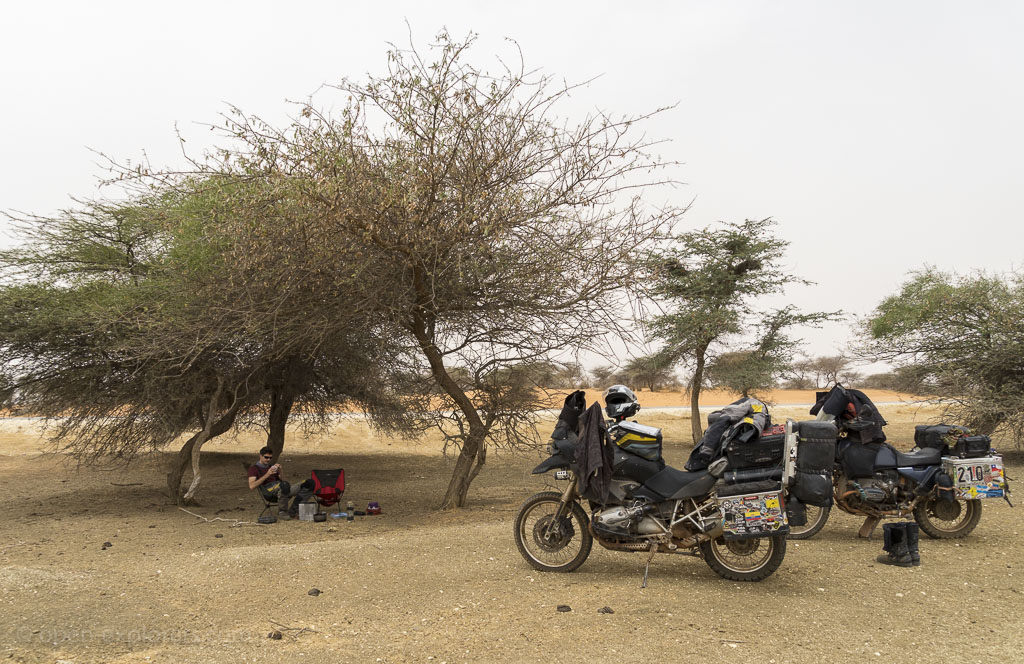
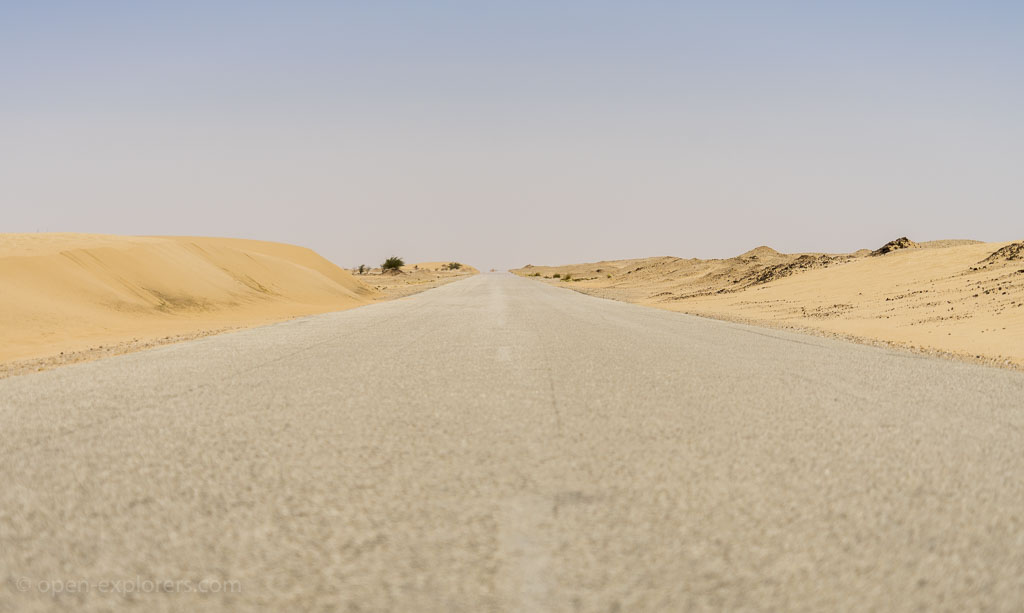
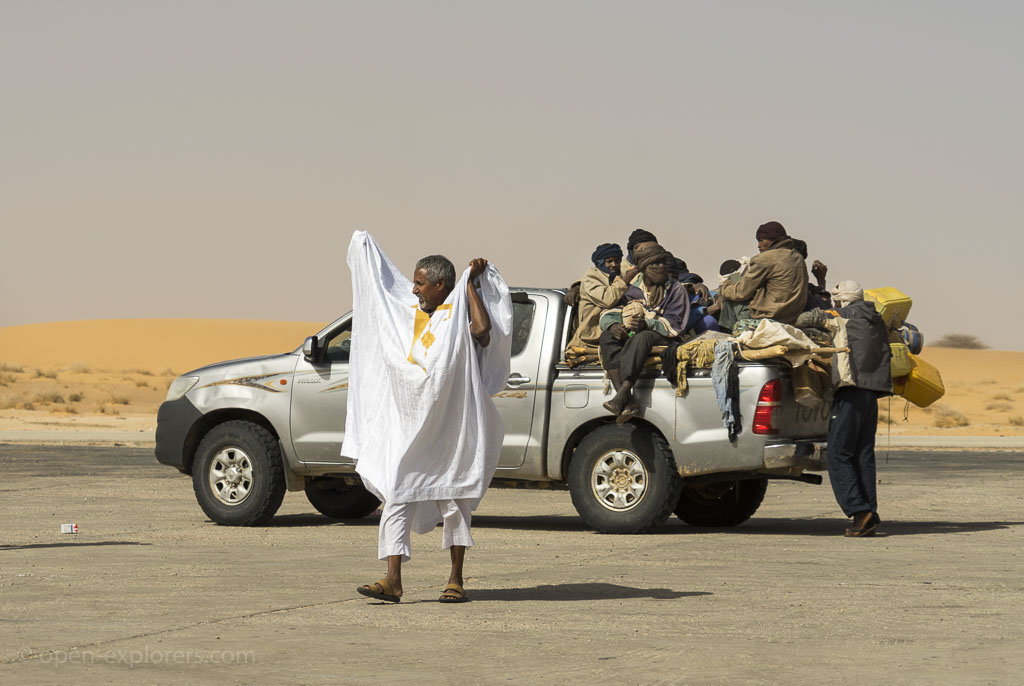
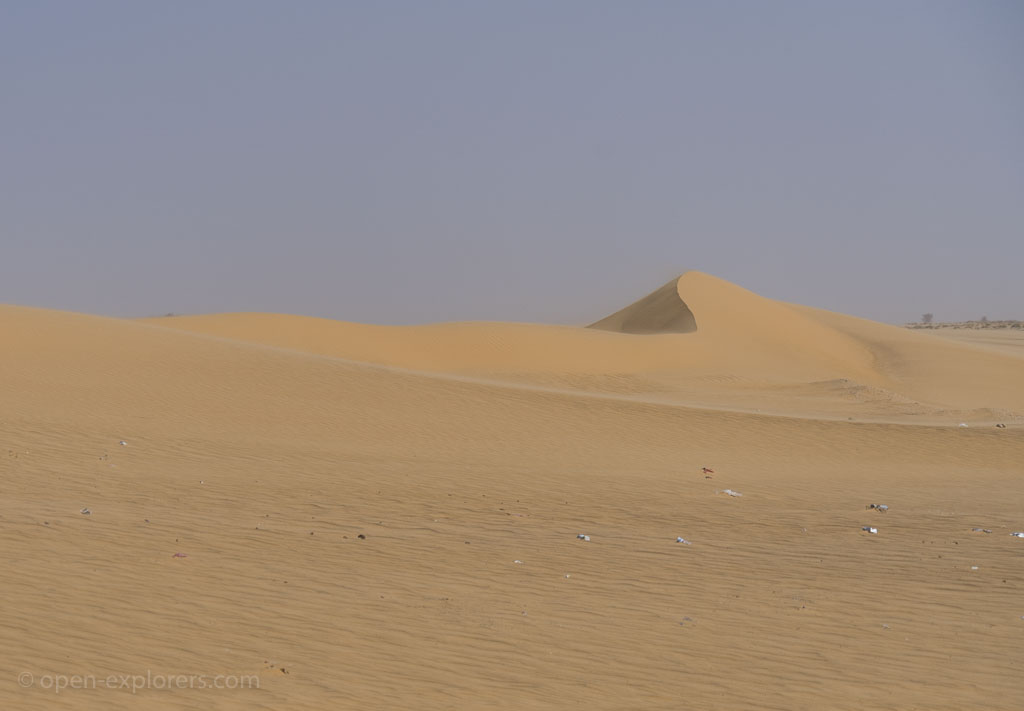
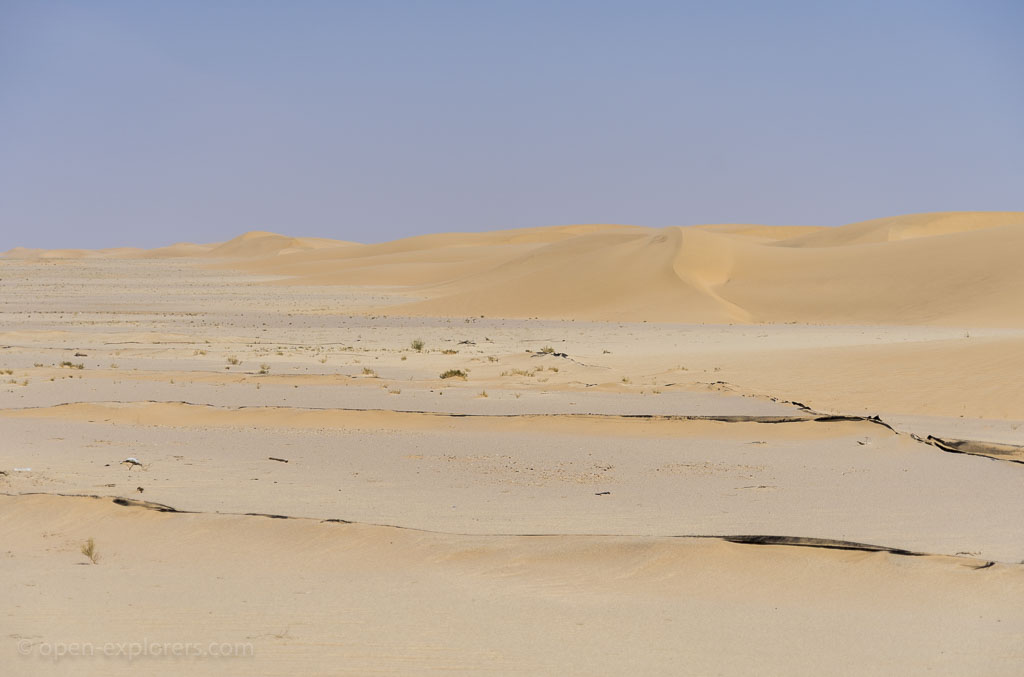
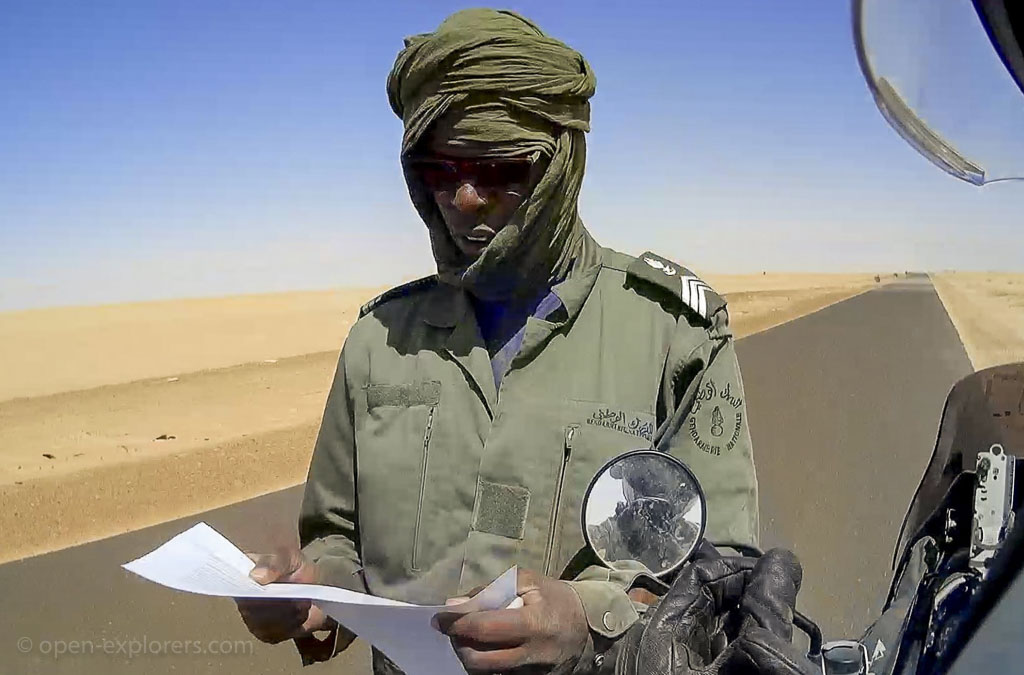
I've mentioned the rather tiresome police and military checkpoints throughout Africa (not southern Africa) before. But they are worth mentioning again because here in Mauretania and Western Sahara they are much less annoying because someone has come up with the "fiche". Generally speaking fiche is the french word for a piece of paper and in this specific context the piece of paper contains all information about the rider and the bike. At a checkpoint we only have to hand over the fiche and within less than a minute we are good to go again. And I think we've also been very lucky by handing out "only" 30 fiches. From other travellers we heard/read that they needed between 50-80 fiches on the same route.
Ich hatte die eher nervigen Polizei- und Militär Checkpoints in Afrika (ausser im südlichen Afrika) ja schon mal erwähnt. Aber sie sind's wert nochmal erwähnt zu werden, denn hier in Mauretanien und der Westsahara hat sich irgend jemand den "fiche" ausgedacht, was sie ein bisschen weniger nervig macht. Im Allgemeinen bezeichnet das französische Wort fiche ein Stück Papier und in diesem speziellen Kontext ein Stück Papier, auf dem all unsere und die Daten der Motorräder stehen. Am Checkpoint übergibt man das dann einfach und kann in weniger als einer Minute schon wieder unterwegs sein. Offensichtlich haben wir aber auch ganz schön Glück gehabt und in den vergangen 5 Tagen "nur" 30 Fiches verteilt. Von anderen Reisenden haben wir gelesen/gehört, dass sie 50-80 Fiches in Umlauf gebracht haben.
